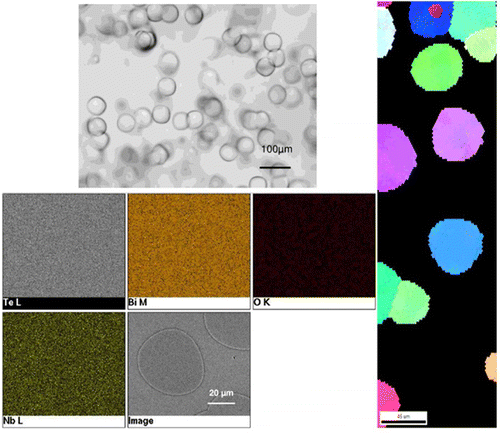Ask for a reprint
email :
* Give your email
2015
ACL
|
A.Bertrand, J.Carreaud, G.Delaizir, M.Shimoda, J.R.Duclère, M.Colas, M.Belleil, J.Cornette, T.Hayakawa, C.Genevois, E.Véron, M.Allix, S.Chenu, F.Brisset, P.Thomas, 'New transparent glass-ceramics based on the crystallization of “anti-glass” spherulites in the Bi2O3-Nb2O5-TeO2 system', Cryst. Growth Des. 15 5086 (2015) doi:10.1021/acs.cgd.5b01048
The crystallization of the Bi0.5Nb0.5Te3O8 (7.14 Bi2O3−
7.14Nb2O5−85.72TeO2) glass composition shows numerous original spherulite-like shape or “droplets” crystalline domains through the bulk. Both SEM-EDS and microprobe measurements demonstrate that both these droplets and the glassy matrix present the same composition. The combination of information obtained from various complementary techniques, electron probe microanalysis, Raman, and SEM-EDS, then leads to the identification of the spherulites as a new Bi0.5Nb0.5Te3O8 “anti-glass” phase. However, the crystallization mechanism is complex
since microcracks are observed at the surface of the spherulites in some glass-ceramic materials, suggesting a confined crystal growth. Therefore, the crystallization process appears much different from a homogeneous congruent crystallization. The photoluminescence (PL) properties of the (1 wt %) Er2O3-doped Bi0.5Nb0.5Te3O8 glass-ceramics were investigated during isothermal crystallization of the parent glass at 380 °C. The evolution of the PL signal (4I13/2 → 4I15/2 transition)
enables indirect detection of the first steps of crystallization. Moreover, the PL data indicate random nucleation with respect to the location of Er3+ ions, whereas the integrated PL intensity and lifetime
values show very comparable evolution trends as a function of the crystallization rate.
|

|